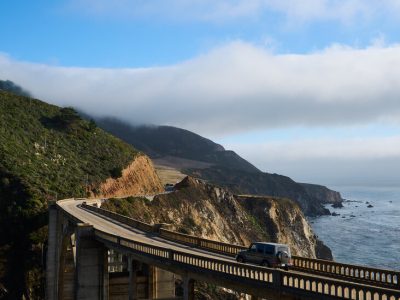Street lights strobed through the window, sending shadows sweeping across our faces as our train followed the River Seine through Choisy-le-Roi. Ten minutes earlier, we had pulled out of Paris’s Gare d’Austerlitz. Departing at 9.40pm, the Intercité de Nuit was due on the Spanish border just after 10am, where we would connect to a Barcelona train.
It’s possible to make the journey from London in a day, but my husband and I had added a stopover to give our two daughters – aged six and four – a whistlestop tour of the French capital, an indulgent lunch and a night on a sleeper train. Travelling with children was once a stop-start nightmare of whingeing for snacks, but instead of fighting them, I’d learned to embrace it by turning each journey into a voyage of gastronomic discovery.
The day before we checked in to 25hours Hotel Paris, opposite Gare du Nord, then set off to Montmartre, where we rode the old Carrousel de Saint-Pierre. With the help of online gastro guide Le Fooding we found the ideal place to eat just 15 minutes’ walk away. A buffet restaurant where children are charged €1.50 times their age, Boulom served everything from roast pork shoulder and marinated beef rib to pots of salty cockles, clams and prawns. It was like eating in a Michelin-starred school dining hall.
Picking up croissant loaves for breakfast from Boulom’s bakery, we swung by the foot of the Eiffel Tower for ice-cream as an evening chill set in. Waiting for night trains involves a lot of hanging around bars and cafes, which is often hard with kids but we killed time at the hotel (playing Uno, hopping into pyjamas). Before we’d left Paris they were asleep, eye masks in place, water bottles wobbling in their racks.
Our four-person compartment had wide berths, proper pillows and nifty sleeping-bag duvets and we woke to views of sunkissed farmland. Ascending more than 1,500 metres through the Midi-Pyrénées, the train clattered through sudden snowscapes with stations no bigger than cottages. At Latour-de-Carol we transferred to the R3 train for a three-hour meander that had us glued to the windows and the beauty of the Pyrenees. In the final hour schoolkids piled on board, and the train slowed into the city, depositing us at Plaça de Catalunya.
Our base was the Eric Vökel Sagrada Familia Suites, a stone’s throw from the liveliness of Avinguda Gaudí. It is contemporary, spotless and nicely located for a stroll down to the trippy magnificence of Gaudí’s unfinished basilica or a half-hour walk to Park Güell. Protests against overtourism have been held on Barcelona’s streets this summer, but we were visiting off-season and planned to seek local and out-of-the-centre experiences.
On the first morning we set off uphill to the quiet neighbourhood of La Salut, stopping at a door in a wall with twirly writing. A woman with softly greying hair answered the bell. “Welcome, would you like to see the secret garden?” she asked the girls, leading us through a kitchen into a patio shaded by a giant ombú tree. Lights hung between the branches, the scent of mimosa was warm on the air and in the centre was a table and two giant paella pans, ready for our class.
In 2012, Sara Casté Obiols, an interior designer, launched La Salsamenta cookery school after hearing visitors pass her family home en route to Park Güell, and thinking she might expand her teaching beyond neighbours and friends. After lockdown, her younger sister Clara joined her to help teach their grandmother’s recipes.
Alongside a family from Florida, we were handed aprons and glasses of peachy white grenache before Clara fired up the pans and passed round ramekins of fresh sofrito (a blend of garlic, peppers and tomato in oil) to taste. Running bomba rice through their fingers, the girls listened to Clara explain that paella was 15th-century Valencian peasants’ food into which they threw whatever they had: rabbit; snails; garrofón (butter) beans, but never ever chorizo.
We split into two groups – one for the seafood version and one for the rabbit and chicken. The girls got on with frying calamari, tossing in rice and ladling in stock, the aroma of saffron rising with the steam. “Never stir paella,” Clara warned, “this releases starch and we want the rice to be firm, with socarrat – Catalan for the crisp, burnt bottom layer.”
Seated at a long table laden with chilled tortilla de patatas and salad, we watched Clara prepare pa amb tomàquet (the original Catalan pan con tomate) rubbing split garlic cloves and grated tomato across pa de pagès (farmers’ bread). Rich, with a light crunch, the paella was sensational, both pans cleared in minutes and followed with strawberries from the market. “You must take them there,” said Clara, as I picked her brains about where to go next, “they will have a wonderful time tasting everything. But my children? They love the CosmoCaixa science museum.”
after newsletter promotion
That afternoon, a little out of the city, near Mount Tibidabo, we stood in the jungle listening to tropical rains drum on lily leaves, piranhas turning in the pool. Known as the Flooded Forest, this 1,000-sq-metre section of the CosmoCaixa is a recreation of the Amazon’s ecosystem and the highlight of the five-storey museum. At just €8 for adults and under-16s going free, it’s a dreamy venue where parents can relax as kids are encouraged to run around touching everything, experimenting in the maths lab, weather station and Antarctic base. After three hours of staring at hair under microscopes, firing water jets and testing the speed of paper planes, I could see why Clara’s kids came on repeat visits.
A jam-packed day behind us – and in need of peace – we sought out La Terraza, the rooftop restaurant of the Grand Hotel Central. Over plates of the smoothest croquetas and crisp calamari, we took in a panoramic sweep of the city, terracotta tiles shimmering in the heat.
Unavoidable for first-timers to the city, La Rambla is both the best and worst of Barcelona, but it’s home to La Boqueria market, where Clara had suggested we take the girls for breakfast. Started in 1217 as a jumble of stalls, the market teemed with local shoppers picking up groceries. Munching on sticks of smoked fuet sausage, the girls watched as haunches of jamón ibérico were slapped and sliced into slivers and were thrilled by the Technicolor hues of strawberries dipped in chocolate and dragon fruit whizzed into smoothies.
Back in the sunshine, we stumbled upon Plaça de Vicenç Martorell, a leafy square with a playground and parrots squawking in the trees. For this reason alone, Barcelona is pure magic for parents, with playgrounds hidden in many corners. They’re often by bars where adults sip Mahou beers and watch their kids on the swings. We weren’t killing time until departure but savouring every moment as the girls dug in sand. Contemplating the trip as a whole, Barcelona felt utopian to our frazzled London minds.
Accommodation was provided by 25hours hotels in Paris (doubles from €152 room-only), and Eric Vökel Boutique Apartments in Barcelona (two-bedroom apartment from about €255 B&B). La Salsamenta paella class: €62 adults, €30 children (6-11)










